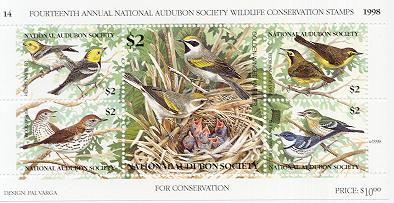Five species of wildlife with declining populations have been added to New Jersey’s endangered list, and nine species have been added to the threatened list, the state Department of Environmental Protection announced. The newly-endangered are three species of birds - the black rail Laterallus jamaicensis, the golden-winged warbler Vermivora chrysoptera and the red knot Calidris canutus; the gray petaltail Tachopteryx thoreyi, a species of dragonfly; and the Indiana bat, which is listed as federally endangered. The newly-threatened are three species of birds - the American kestrel, the cattle egret and the horned lark; and six dragonfly species.
Source: New Jersey News Room, 23 February 2012
http://www.newjerseynewsroom.com/science-updates/black-rail-golden-wing…
The Black Rail (Laterallus jamaicensis) is found in scattered parts of North America and the Pacific region of South America, usually in coastal salt marshes but also in some freshwater marshes. The largest populations in North America are in Florida and California. Black Rails appear to be omnivorous, feeding primarily on small invertebrates but also on seeds of some marsh plants.
Source: Wikipedia
http://en.wikipedia.org/wiki/Black_Rail
The Golden-winged Warbler, Vermivora chrysoptera, breeds in southeastern and south-central Canada and the Appalachian Mountains northeastern to north-central USA. The majority (~70%) of the global population breeds in Wisconsin, Minnesota, and Manitoba. Golden-winged Warblers breed in open scrubby areas, wetlands, and occasionally mature forest adjacent to those habitats. These birds feed on insects, and spiders, most often leaf-roller caterpillars. Golden-winged Warblers have strong gaping (opening) musculature for their bill, allowing them to uncover hidden caterpillars.
Source: Wikipedia
http://en.wikipedia.org/wiki/Golden-winged_Warbler
The Red Knot, Calidris canutus (just Knot in Europe), is a medium sized shorebird which breeds in tundra and the Arctic Cordillera in the far north of Canada, Europe, and Russia. Their diet varies according to season; arthropods and larvae are the preferred food items at the breeding grounds, while various hard-shelled molluscs are consumed at other feeding sites at other times. North American breeders migrate to coastal areas in Europe and South America, while the Eurasian populations winter in Africa, Papua New Guinea, Australia and New Zealand.
Source: Wikipedia
http://en.wikipedia.org/wiki/Red_Knot
The gray petaltail is found throughout the eastern United States, in New Jersey it is limited to Bergen, Morris, Passaic, and Sussex Counties. This woodland species is found in small seepages in habitat abundant with skunk cabbage and ferns. Nymphs feed on aquatic invertebrates. Gray petaltail adults feed on large flying insects including other dragonflies.
Source: Conserve Wildlife Foundation of New Jersey
http://www.conservewildlifenj.org/species/fieldguide/view/Tachopteryx%2…
The Indiana bat (Myotis sodalis) is a medium-sized mouse-eared bat native to North America. It lives primarily in eastern and midwestern states and in parts of the south of the United States. Indiana bats live in hardwood forests and hardwood-pine forests. It is common old-growth forest as well as agricultural land like croplands and old fields. Overall, the bats mostly live in forest, crop fields, and grasslands. As an insectivore, the bat will eat both terrestrial and aquatic flying insects like moths, beetles, and mosquitoes and midges.
Source: Wikipedia
http://en.wikipedia.org/wiki/Indiana_bat
The American Kestrel (Falco sparverius), sometimes colloquially known as the Sparrow Hawk, is a small falcon, and the only kestrel found in the Americas. Its breeding range extends from central and western Alaska across northern Canada to Nova Scotia, and south throughout North America, into central Mexico and the Caribbean. It nests in cavities in trees, cliffs, buildings, and other structures. Its diet typically consists of grasshoppers, lizards, mice, and other small birds.
Source: Wikipedia
http://en.wikipedia.org/wiki/American_Kestrel
The Cattle Egret (Bubulcus ibis) is a cosmopolitan species of heron (family Ardeidae) found in the tropics, subtropics and warm temperate zones. The species first arrived in North America in 1941 (these early sightings were originally dismissed as escapees), bred in Florida in 1953, and spread rapidly, breeding for the first time in Canada in 1962. It is now commonly seen as far west as California. It nests in colonies, usually near bodies of water and often with other wading birds. Although the Cattle Egret sometimes feeds in shallow water, unlike most herons it is typically found in fields and dry grassy habitats, reflecting its greater dietary reliance on terrestrial insects rather than aquatic prey.
Source: Wikipedia
http://en.wikipedia.org/wiki/Cattle_Egret
The Shore Lark (Eremophila alpestris), called the Horned Lark in North America, breeds across much of North America from the high Arctic south to the Isthmus of Tehuantepec, northernmost Europe and Asia and in the mountains of southeast Europe. This is a bird of open ground. In Eurasia it breeds above the tree line in mountains and the far north. In most of Europe, it is most often seen on seashore flats in winter, leading to the European name. In the UK it can be found as a winter stopover along the coasts and in eastern England although a mated pair have been recently spotted in Windmill End nature reserve in the West Midlands. In America, where there are no other larks to compete with, it's also found on farmland, on prairies, in deserts, on golf courses and airports, and the like. Food is seeds supplemented with insects in the breeding season. The nest may be near corn or soybeans for a source of food, and the female chooses the site.
Source: Wikipedia
http://en.wikipedia.org/wiki/Shore_Lark

- Log in to post comments
